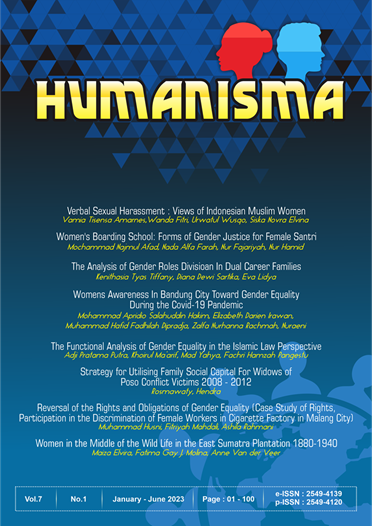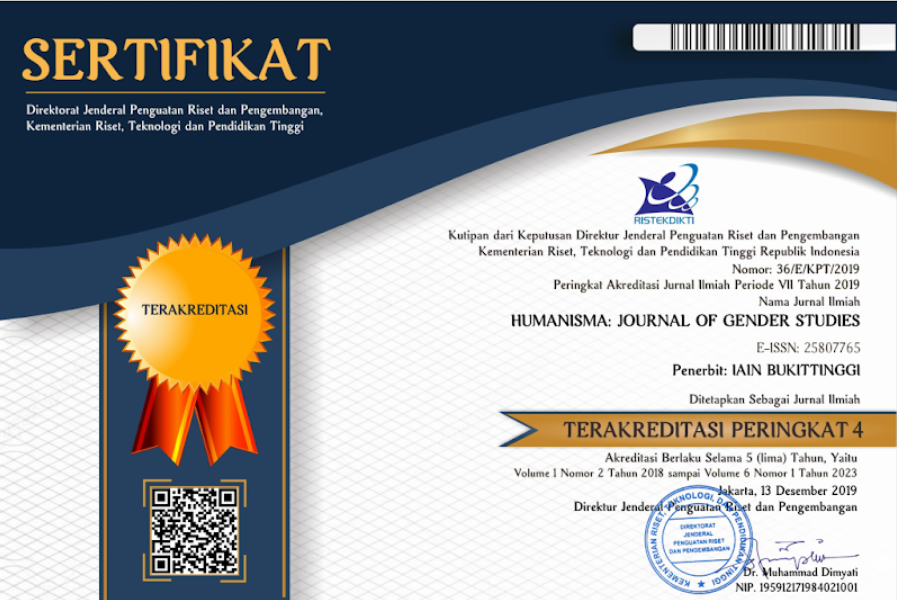Verbal Sexual Harassment : Views of Indonesian Muslim Women
DOI:
https://doi.org/10.30983/humanisme.v7i1.6201Keywords:
Perception, Verbal sexual harassment, Women,Abstract
This study aims to determine women's views on verbal sexual harassment in terms of cognitive, affective, and conative factors. This is due to the increasing number of acts of sexual harassment that occur against women, one of which is in the public sphere. Forms of verbal sexual harassment that occurred in the form of whistling, negative speech, seduction, comments, sharp stares at body parts, or physical abuse The research method used is a qualitative method. Data were collected through observation and interviews. There were 33 participants involved in the research. The determination of research subjects used a purposive sampling technique. The research subjects were students of UIN Imam Bonjol Padang, UIN Sjech Djamil Djambel Bukittinggi, and UIN Mahmud Yunus Batusangkar. The research results show that on the cognitive aspect, there were participants who knew and did not know about verbal sexual harassment. In the affective aspect, all participants felt uncomfortable, irritated, anxious, and afraid. In the conative aspect, some informants resisted and some did not; this was because the participants were afraid of the perpetrators and did not want to ignore the actions they received. The implication of the research is to raise people’s awareness that harassment is not only physical but also verbal.
Â
 ÂReferences
Journal
Al-Rahman, Naufal. Verbal Sexual Harassment of Hijab-wearing Female Students (Study on the Meaning of Verbal Sexual Harassment Experiences for Hijab-wearing Female Students in the City of Surabaya). Airlangga University Library Journal 10, no. 2 (2019): 119.
Angeline, Hidayat, and Setyanto Yugih. "The catcalling phenomenon as a form of verbal sexual harassment against women in Jakarta." Journal of the Faculty of Communication Sciences, University of Tarumanegara 3, no. 2 (2019): 48592.
Bahri, Syaiful, and Fajriani. A Preliminary Study of the Levels of Sexual Harassment in Aceh.Journal of Enlightenment 9, no. 1 (2015): 5065.
Desi, and Ida Ayu Adnyaswari. “Catcalling¯: Jokes, Compliments, or Sexual Harassment.Journal of Notary Law 4, no. 2 (2019): 198-211.
Hayati, Eli Nur. Guide for Companion of Women Victims of Violence : Gender - Insighted Counseling . Yogyakarta: Rifka Anisa and the Learning Library, 2000.
Ishmael. “Factors Influencing Sexual Harassment In the Malaysian Workplace.†Asian Academy of Management Journal 12, no. 2 (2007): 15–31.
Wardhani, Yurika Fauzia, and Weni Lestari. “Post Traumatic Stress Disorder in Victims of Sexual Assault and Rape.†Journal of Society, Culture, and Politics , 2007, 18.
Books
Danarjati, Dwi Prasetia. Introduction to General Psychology . Yogyakarta: Graha Ilmu, 2013.
Herdiansyah, Haris. Qualitative Research Methods . Jakarta: Salemba Humaika, 2012.
Khairani, Makmun. General Psychology . Yogyakarta: Aswaja Presisindo, 2016.
Robbins, Stephen P. Organizational Behavior Book I . Jakarta: Selemba Empat, 2003.
Sears, DO Social Psychology . Jakarta: Kencana, 2009.
Thoha, Miftah. Organizational Behavior . Jakarta: Raja Grafindo Persada, 2003.
Walgito, Bimo. introduction to general psychology . Yogyakarta: Andi Offset, 2003.
Others
Komnas Perempuan. "15 Forms of Sexual Violence: An Introduction," 2017. https://komnasperempuan.go.id/instrumen-modul-reference-pemantauan-detail/15-shape-kekerasan-sexual-a-pengenalan.
lubis, Namora Lamongga. Reproductive Psychology : Women & their reproductive development is reviewed from the physical and psychological aspects . Jakarta: Kencana, 2016.
Magdalene. "90 Percent of Rape Victims in Indonesia Are Silent," 2016. https://www.dw.com/id/90-persen-korban-pemerkosaan-di-indonesia-bungkam/a-19427038.
O'Leary, Collen. Catcalling as a 'double edged sword'. Midwestern women, their experience, and the implications of men's catcalling behaviors.Illinois State University, 2016.
Primastika, Widia. Harassment Is Not the Result of Clothing; Loose clothes & hijab are also subject to it," 2019. https://tirto.id/pelecehan-bukan-akibat-dinding-berbaju-longgar-berhijab-pun-kena-eeFQ.
Downloads
Published
How to Cite
Issue
Section
Citation Check
License
Copyright (c) 2023 Vamia Tisensa Amarnes, Wanda Fitri, Urwatul Wusqo, Siska Novra Elvina

This work is licensed under a Creative Commons Attribution-ShareAlike 4.0 International License.
Authors who publish with this journal agree to the following terms:
- Authors retain copyright and grant the journal right of first publication with the work simultaneously licensed under a Creative Commons Attribution-ShareAlike 4.0. that allows others to share the work with an acknowledgment of the work's authorship and initial publication in this journal.
- Authors are able to enter into separate, additional contractual arrangements for the non-exclusive distribution of the journal's published version of the work (e.g., post it to an institutional repository or publish it in a book), with an acknowledgment of its initial publication in this journal.
- Authors are permitted and encouraged to post their work online (e.g., in institutional repositories or on their website) prior to and during the submission process, as it can lead to productive exchanges, as well as earlier and greater citation of published work (See The Effect of Open Access).



